12 Best Sales Prospecting Tools to Dominate in 2025
Effective sales prospecting is the engine of revenue growth. It's the crucial first step in filling your pipeline with qualified leads who are genuinely interested in what you offer. But manually searching for prospects, verifying contact details, and identifying buying signals is a time-consuming, inefficient process that drains resources and slows down your sales cycle. The right technology can transform this grind into a strategic, data-driven advantage.
This guide provides a comprehensive breakdown of the best sales prospecting tools available today. We move beyond generic feature lists and marketing jargon to deliver a practical analysis of what each platform actually does, who it's for, and how it can solve specific business challenges. Whether you're a solopreneur needing high-intent leads, a small marketing team aiming to scale outreach, or a large sales organization looking to optimize performance, this resource is designed to help you make an informed decision.
Each tool profiled below includes a detailed review covering its core functionality, ideal user, pricing considerations, and a candid look at its pros and cons. We’ve also included screenshots to give you a feel for the user interface and direct links to explore each option further. Our goal is to equip you with the insights needed to select the software that will not just find you more leads, but will connect you with the right leads, faster. We'll start with a powerful solution for identifying buyer intent, Intently, before diving into other industry-leading platforms.
1. Intently
Intently positions itself as a premier choice among the best sales prospecting tools by transforming social listening into a powerful, AI-driven lead generation engine. It moves beyond simple keyword tracking by leveraging sophisticated NLP and machine learning to analyze conversations on high-traffic platforms like Reddit, X (formerly Twitter), and LinkedIn. This allows GTM teams to identify not just mentions, but genuine purchase intent, urgency, and sentiment, cutting through the noise to find prospects actively seeking solutions.
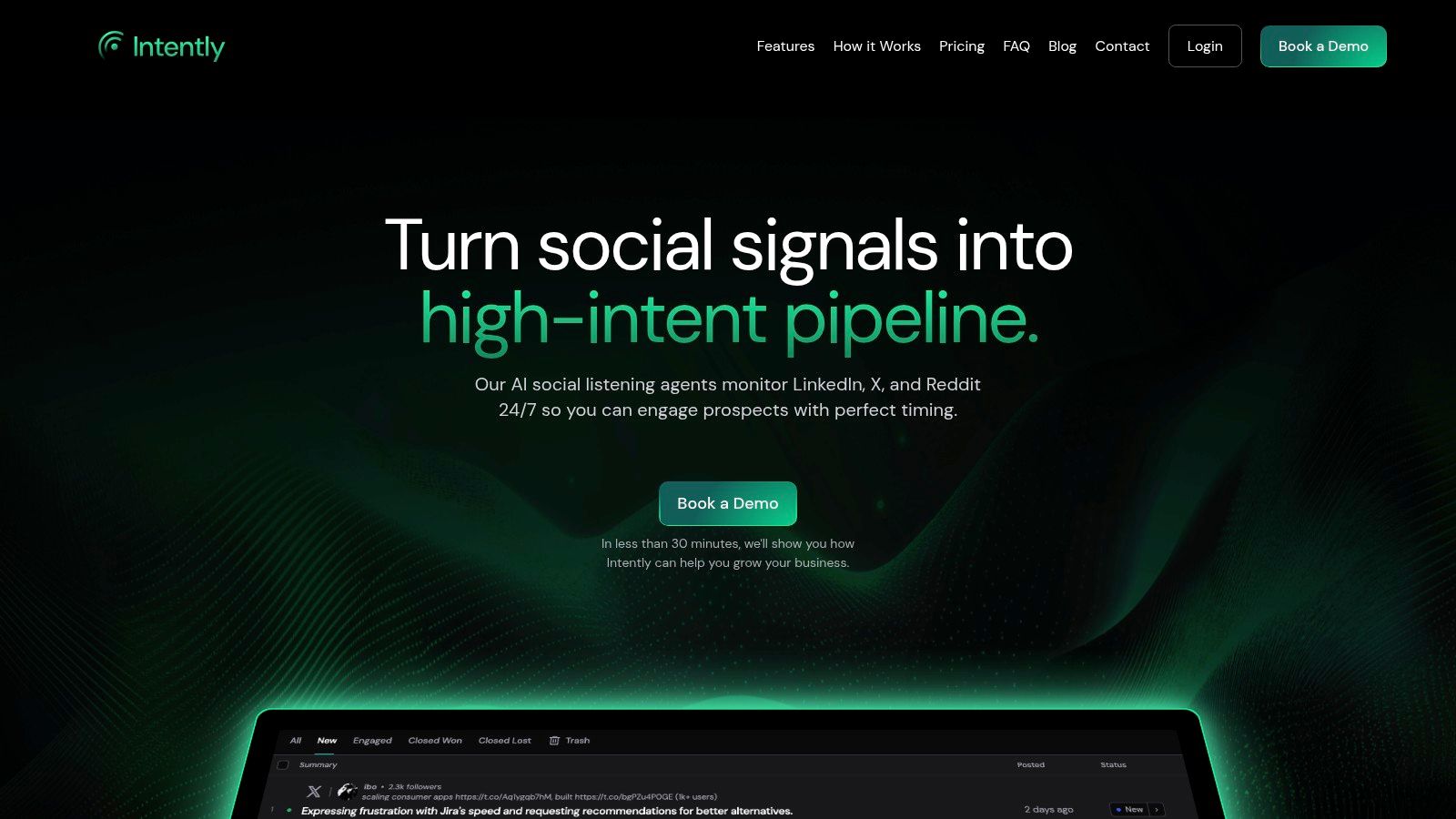
Its core strength lies in its ability to deliver a curated stream of high-intent leads directly into your workflow. Instead of manually scouring platforms, users receive real-time alerts via Slack or email when conversations matching their custom criteria pop up. This proactive approach ensures sales teams can engage warm leads at the perfect moment, dramatically increasing response rates and conversion potential.
Key Strengths & Use Cases
High-Intent Lead Discovery: Intently's AI excels at identifying "buying signals" within online discussions. For example, a sales team can set up a monitor for phrases like "recommend a CRM for a small business" or "alternative to [competitor product]" and receive instant notifications. This is a game-changer for B2B sales professionals looking for in-market buyers. To deepen your understanding of this modern approach, Intently offers a detailed guide to effective B2B lead generation.
Competitive Intelligence: Brand managers and product researchers can monitor mentions of competitors to identify pain points, feature requests, or customer churn signals. This provides invaluable data for refining your product positioning and marketing messages.
Customizable Monitoring: The platform's flexibility allows users to set monitoring frequency (hourly, daily, weekly) and define precise intent signals, ensuring the leads generated are highly relevant and actionable. This prevents alert fatigue and focuses efforts where they matter most.
Practical Considerations
Intently operates on a flexible, credit-based model with tiered pricing starting at an accessible $49 per month, making it suitable for everyone from solopreneurs to larger sales organizations. While its focus on Reddit, X, and LinkedIn is a strength for B2B and B2C brands active on those channels, teams needing insights from platforms like Facebook or Instagram will need to supplement their strategy. The platform's seamless integration with Slack and email makes implementation straightforward, allowing teams to start receiving valuable insights almost immediately.
Pros:
- AI-powered monitoring surfaces high-intent leads with context.
- Highly customizable alerts and monitoring schedules.
- Flexible credit-based pricing scales with business needs.
- Direct Slack and email integrations for real-time alerts.
Cons:
- Platform monitoring is currently limited to Reddit, X, and LinkedIn.
- Lacks extensive public case studies or third-party certifications.
2. LinkedIn Sales Navigator
LinkedIn Sales Navigator leverages the platform’s unparalleled professional network, making it one of the best sales prospecting tools for B2B sellers. Its core strength lies in its vast, self-reported, and continuously updated user data, providing a real-time view into company hierarchies, job changes, and professional activities.
The platform excels at identifying key decision-makers through its advanced lead and account search filters. You can pinpoint prospects by seniority, company size, industry, geography, and more, then save them into organized lists. The Account Hub provides real-time alerts on target accounts, such as significant company growth or when a saved lead shares content, creating timely and relevant reasons to engage.
Key Features & User Experience
The user interface is seamlessly integrated into the familiar LinkedIn environment, making it intuitive for existing users. A standout feature is TeamLink, which reveals which of your colleagues are connected to a prospect, facilitating warm introductions.
- Advanced Search & Recommendations: Go beyond standard LinkedIn search with highly specific filters and receive AI-driven lead recommendations.
- Real-Time Alerts: Stay informed about job changes, company news, and when prospects engage with content.
- InMail Credits: Directly message professionals outside your network (50 per month on Core and Advanced plans).
- CRM Integration: Sync leads and accounts with major CRMs like Salesforce and Microsoft Dynamics 365, although deeper integrations often require higher-tier plans.
Practical Tip: Use the "Posted on LinkedIn" filter in your lead search to find active users. Engaging with their recent posts before sending an InMail can dramatically increase your response rates by establishing familiarity.
Pros:
- Unmatched depth and freshness of professional data.
- Operates within a platform where sellers and buyers are already active.
- Intuitive interface with clear self-serve pricing.
Cons:
- Native list exporting capabilities are limited.
- InMail success is highly dependent on message quality.
- Advanced CRM sync and team features are locked behind more expensive plans.
Website: https://business.linkedin.com/sales-solutions
3. ZoomInfo SalesOS
ZoomInfo SalesOS is an enterprise-grade sales intelligence platform renowned for its extensive B2B database. Its primary strength is the depth and accuracy of its US-centric contact and company data, including highly sought-after direct-dial phone numbers and verified email addresses, making it a powerhouse among the best sales prospecting tools for teams targeting North America.
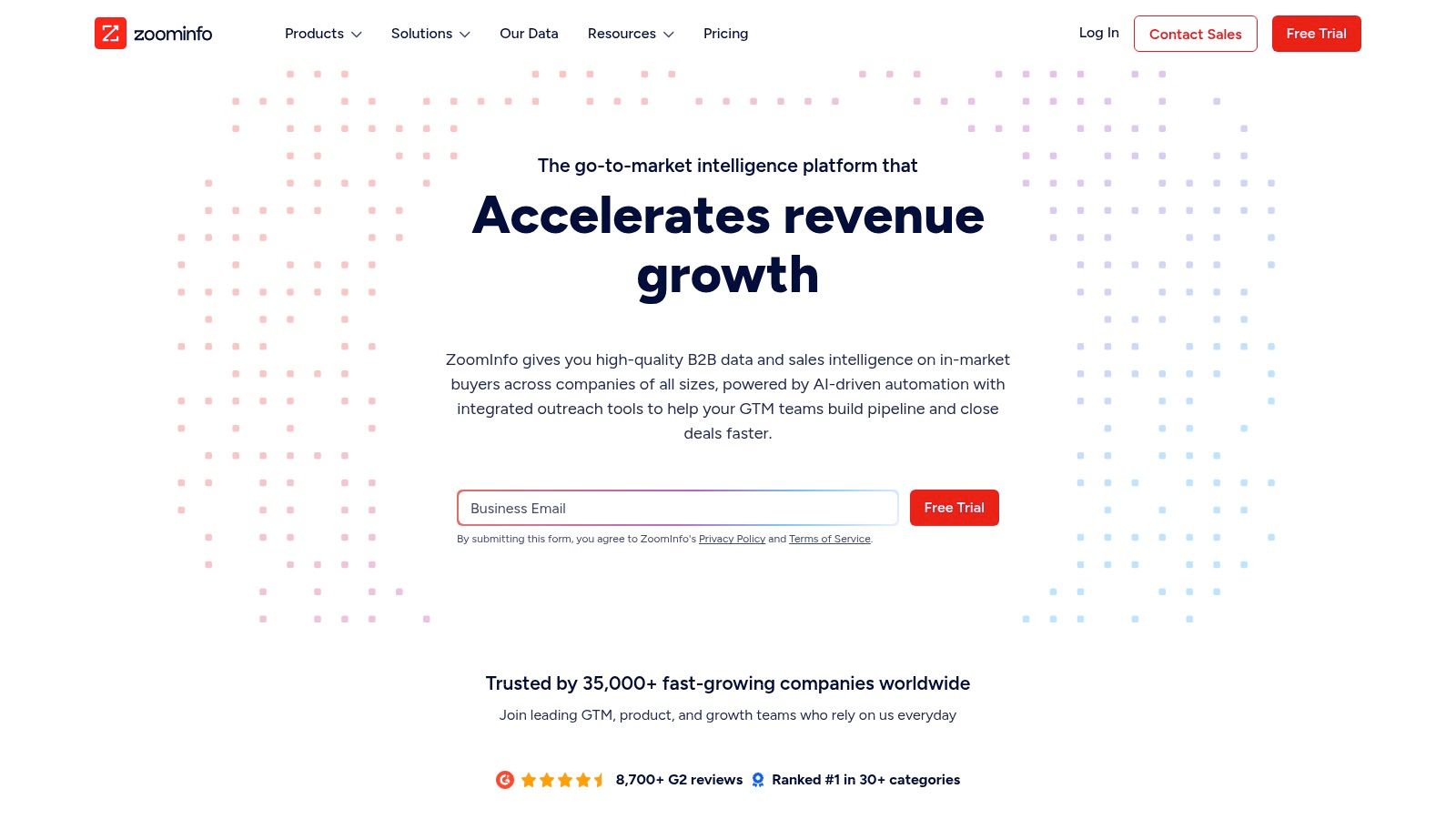
The platform goes beyond simple contact information by providing rich company profiles with organizational charts, intent data, and technographic details. This allows sales teams to identify which companies are actively researching solutions like theirs and understand the technology stack they currently use, enabling highly targeted and timely outreach. Its robust data governance and enrichment capabilities also help maintain CRM data hygiene.
Key Features & User Experience
The user interface is data-dense but functional, designed for power users who need to build complex queries and export lists efficiently. A key feature is its Intent Signals, which track online content consumption to flag accounts showing buying interest in specific topics, moving it beyond a static directory.
- Extensive B2B Database: Access millions of professional profiles with direct dials, email addresses, and detailed company firmographics.
- Intent Data & Technographics: Identify accounts actively researching relevant topics and understand their existing technology stacks.
- Robust Integrations: Seamlessly connect and enrich data within major CRMs and sales engagement platforms like Salesforce, HubSpot, and Outreach.
- Data Enrichment & Management: Keep your internal databases clean and up-to-date with automated data appending and verification.
Practical Tip: Use ZoomInfo's "Scoops" feature to find actionable intelligence like funding announcements, leadership changes, or project initiatives. Mentioning these specific events in your outreach shows you’ve done your research and increases relevance.
Pros:
- Excellent coverage and accuracy for US company data, especially direct dials.
- Mature administrative controls and strong integration ecosystem.
- Advanced features like intent data and technographics provide a competitive edge.
Cons:
- Pricing is quote-based and often requires expensive, multi-year contracts.
- The credit-based system for viewing and exporting data can be complex to manage.
- Cost can be prohibitive for small businesses or startups.
Website: https://www.zoominfo.com
4. Apollo.io
Apollo.io has established itself as a powerful all-in-one sales intelligence and engagement platform, making it one of the best sales prospecting tools for teams that need both data and outreach capabilities in a single solution. Its core strength is combining a massive B2B database with built-in sequencing, a dialer, and analytics, which simplifies the tech stack for many small and mid-market sales teams.
The platform excels at providing a unified workflow where users can find verified email addresses and phone numbers, enroll prospects into multi-step email sequences, and track engagement without switching between applications. This integrated approach, combined with its transparent and accessible pricing, makes it a go-to choice for organizations looking to scale their prospecting efforts efficiently.
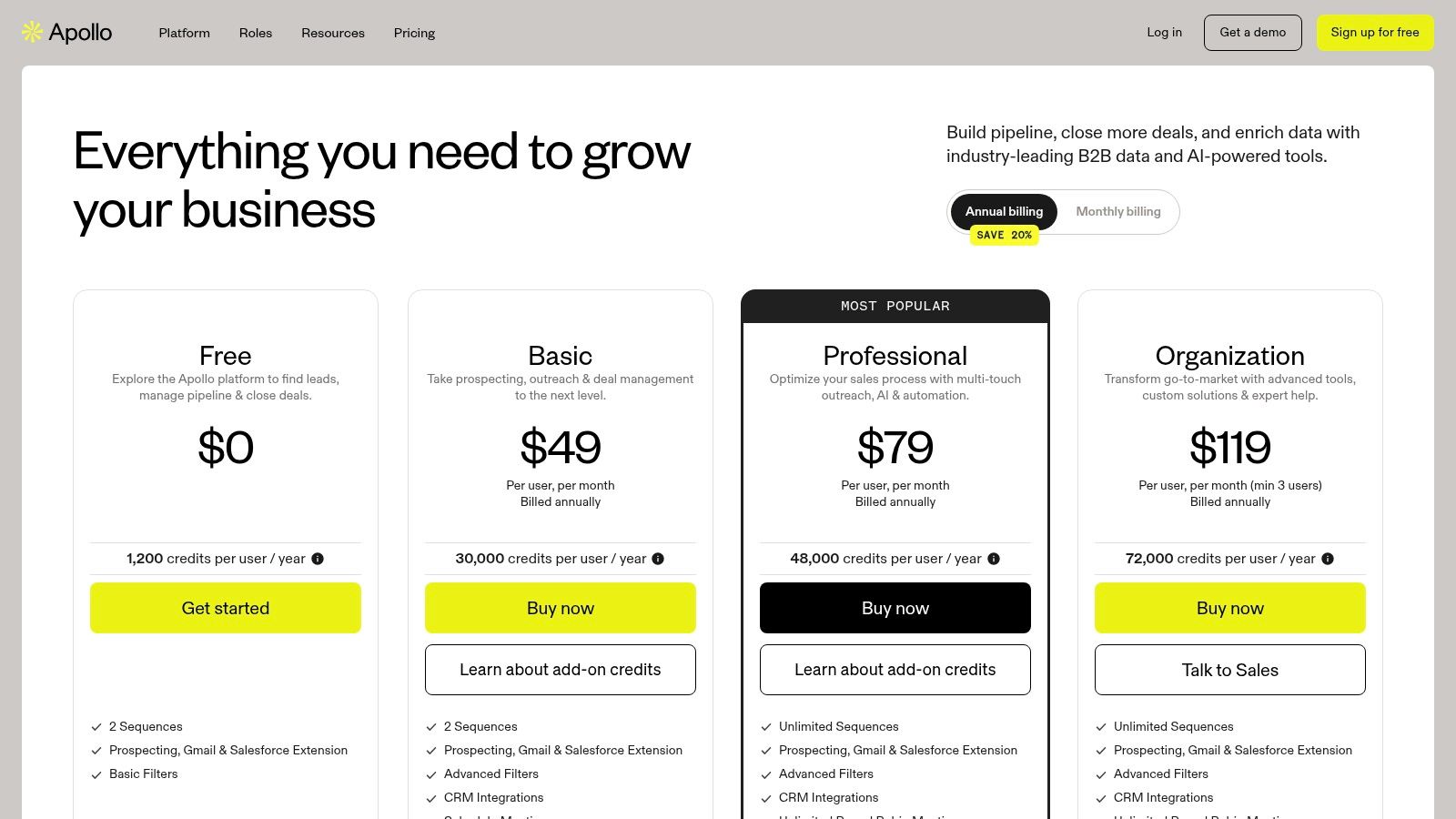
Key Features & User Experience
Apollo's interface is user-friendly and designed for rapid adoption, allowing teams to build lists, launch campaigns, and analyze results quickly. Its Chrome extension is a standout feature, enabling users to prospect directly from LinkedIn and company websites, adding contacts to sequences on the fly.
- B2B Database & Credits: Access a vast contact database with generous email and mobile number credit allowances even on lower-tier plans.
- Email & Call Automation: Build and automate personalized outreach sequences, with an integrated dialer for call-heavy workflows.
- AI-Assisted Tools: Utilize AI for researching prospects and writing effective emails, a key component of modern AI lead generation tools.
- CRM Integration: Offers native integrations with popular CRMs like Salesforce and HubSpot, ensuring data flows seamlessly between platforms.
Practical Tip: Use Apollo's "Plays" feature to automate list building. For example, create a play that automatically adds new VPs of Sales from SaaS companies with 50-200 employees in your territory to a specific prospecting list each day.
Pros:
- Combines prospecting data and outreach tools in a unified, cost-effective platform.
- Generous free tier and clear, affordable per-seat pricing.
- User-friendly interface and powerful Chrome extension for efficient prospecting.
Cons:
- Mobile and direct-dial data can be less comprehensive than enterprise-focused competitors.
- Credit limits on lower-tier plans require careful management to avoid unexpected costs.
- Advanced analytics and governance features are reserved for higher-priced plans.
Website: https://www.apollo.io/pricing
5. HubSpot Sales Hub
HubSpot Sales Hub centralizes sales activities within its powerful CRM, making it one of the best sales prospecting tools for teams seeking an all-in-one solution. Its primary strength is the seamless integration of prospecting, engagement, and reporting, which eliminates the friction of using disconnected systems. This unified approach gives sales reps a complete view of a prospect's history and interactions.
The platform is designed to streamline outreach through a dedicated prospecting workspace. Reps can build automated email sequences, manage call lists, and access AI-powered coaching directly within their workflow. This native integration means less time switching tabs and more time selling, with every action automatically logged in the CRM for complete visibility.
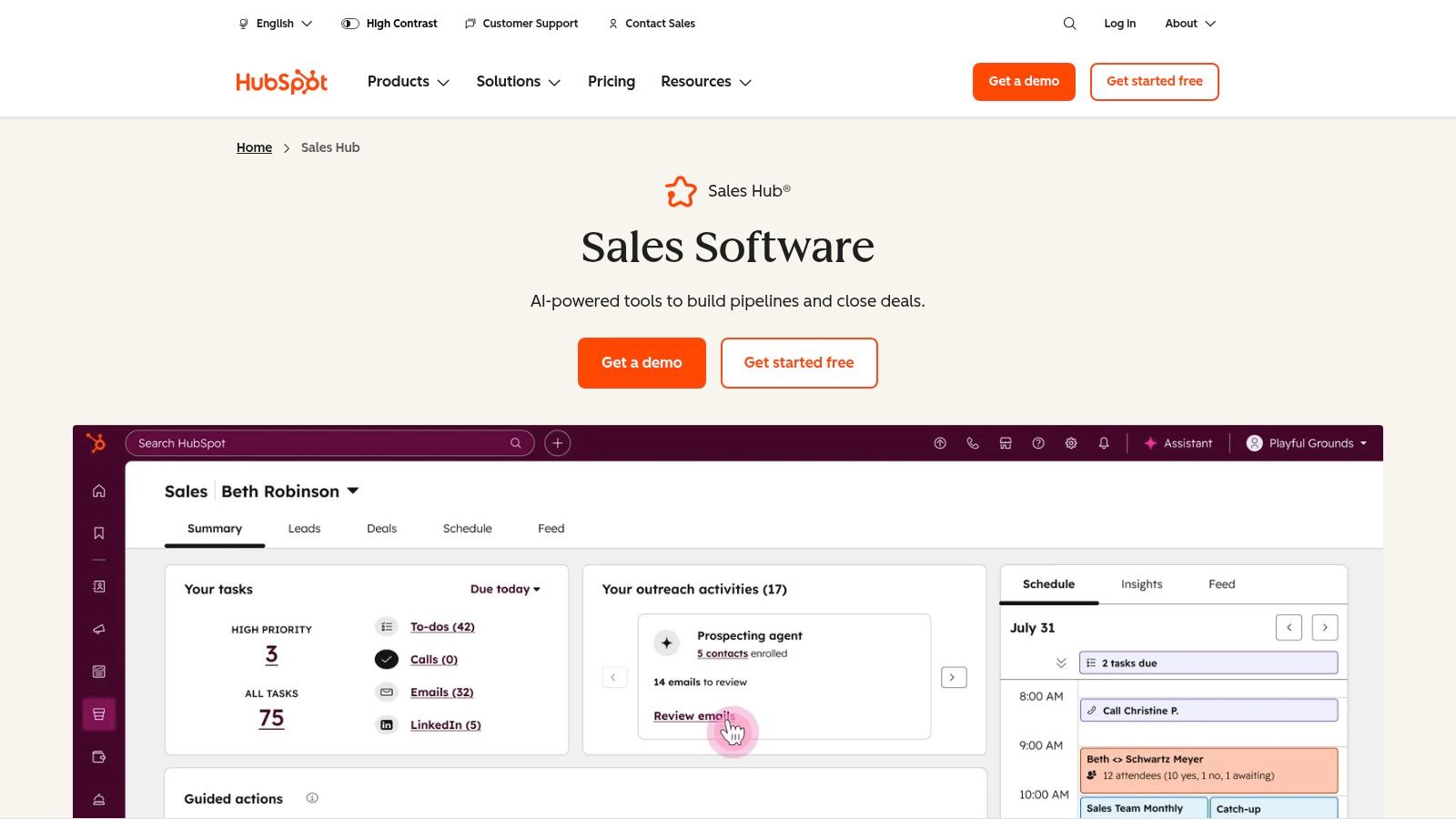
Key Features & User Experience
The user interface is clean and user-friendly, typical of HubSpot’s design philosophy, which simplifies adoption for new reps. A key feature is the Prospecting Workspace, which consolidates tasks and provides a clear, actionable to-do list for reps to follow each day, improving focus and productivity.
- Sequences & Calling: Automate personalized email follow-ups and queue up calls directly from the CRM to maintain consistent outreach.
- Conversation Intelligence (CI): AI-powered tools record, transcribe, and analyze sales calls to provide coaching insights and highlight key moments.
- Reporting & Forecasting: Build custom dashboards to track pipeline health, team performance, and forecast future revenue with data pulled directly from the CRM.
- App Marketplace Integration: Natively connects with the HubSpot CRM and extends its capabilities with a vast marketplace, including integrations like Clearbit for data enrichment.
Practical Tip: Use sales playbooks within the Sales Hub to standardize your team's approach. You can build interactive guides for common objections, product features, and competitive positioning that reps can access directly during a call.
Pros:
- Unified CRM and sales engagement platform enables fast deployment.
- Scales well from free versions to enterprise-level governance.
- Strong ecosystem and integrations for extended functionality.
Cons:
- Provides the best value when used alongside the HubSpot CRM.
- Enterprise-level plans can include onboarding fees and higher per-seat costs.
- Advanced prospecting features are limited in the free or starter tiers.
Website: https://www.hubspot.com/products/sales
6. Outreach
Outreach is a leading sales engagement platform that helps teams systematize their prospecting activities and execute multichannel outreach at scale. It centralizes communication across email, phone, and social platforms, allowing sales development representatives (SDRs) to follow prescribed plays that ensure consistency and effectiveness in their follow-up, a key challenge in modern sales.
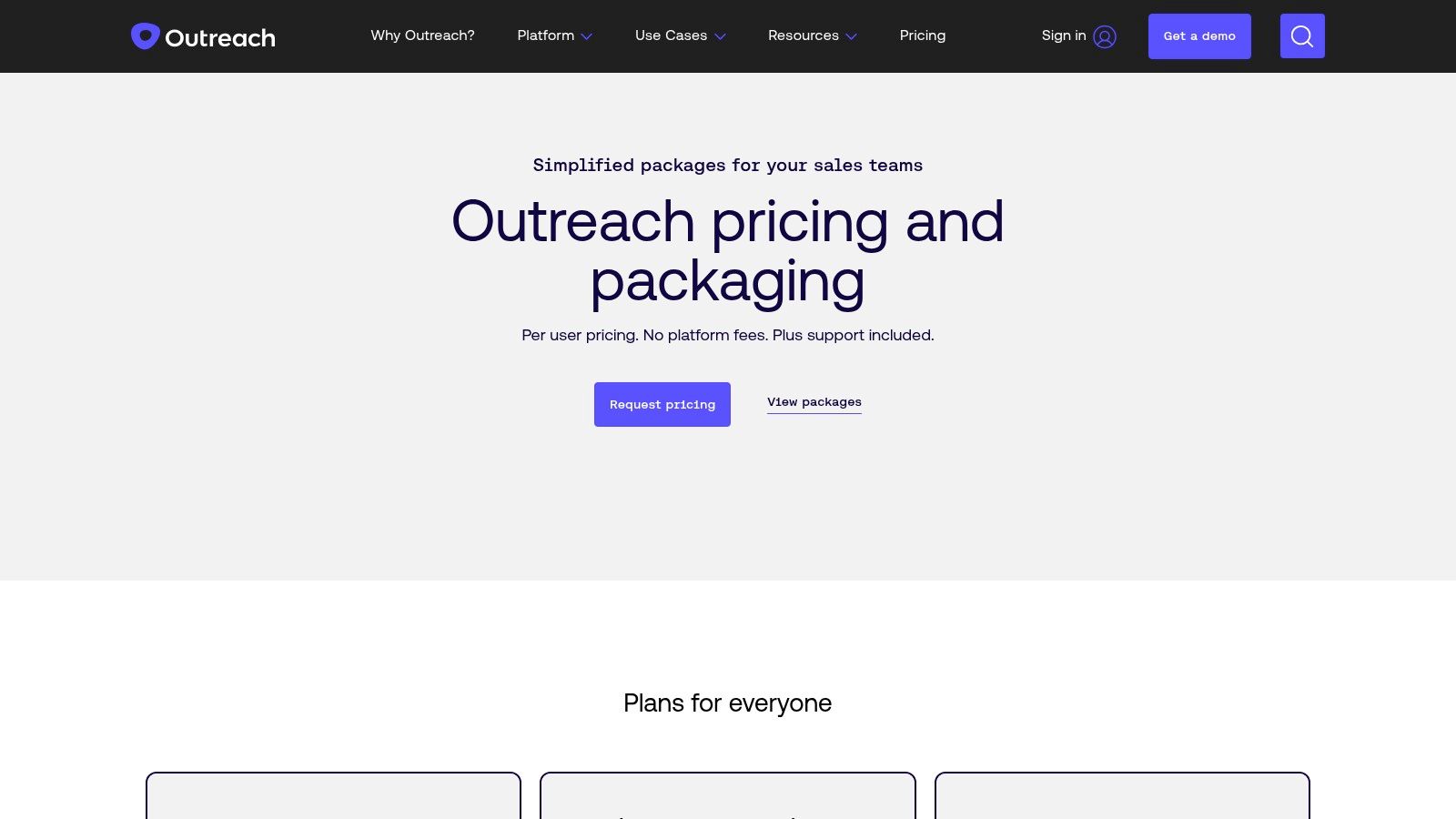
The platform’s strength is in its robust sequencing and automation capabilities, which guide reps through a series of touchpoints for each prospect. Outreach's growing suite of AI tools, like its "Kaia" conversation intelligence, further assists by providing real-time guidance during calls and summarizing key takeaways, making it one of the more comprehensive sales prospecting tools for enterprise teams.
Key Features & User Experience
The interface is built for high-volume activity, presenting reps with a clear, task-oriented workflow each day. Its integrated dialer and email functionalities are deeply embedded within the platform, reducing the need to switch between different applications.
- Multichannel Sequences: Build and automate outreach campaigns across email, phone calls, LinkedIn tasks, and other steps to ensure persistent follow-up.
- Integrated Dialer & Call Intelligence: Make and record calls directly within the platform, with AI-powered features for transcription, summaries, and real-time coaching.
- AI Revenue Agents: Leverage AI to assist with account research, personalizing emails, and identifying key talking points before engaging a prospect.
- Deep CRM Integration: Offers enterprise-grade, bi-directional sync with platforms like Salesforce, ensuring all prospecting activity is logged correctly.
Practical Tip: Use Outreach's A/B testing feature for email templates and sequences. Test different subject lines, call-to-action phrases, and timing to discover what resonates best with your target audience, then operationalize the winning formula across your team.
Pros:
- Robust enterprise-level features with strong governance and permission controls.
- Deep integrations with the broader sales tech ecosystem, especially CRMs.
- Strong focus on AI-driven productivity for the entire sales cycle.
Cons:
- Pricing is available by quote only and can be expensive for smaller teams.
- Implementation often requires significant change management and dedicated admin resources.
- The sheer number of features can create a steep learning curve for new users.
Website: https://www.outreach.io/pricing
7. Salesloft
Salesloft is a comprehensive sales engagement platform that goes beyond simple prospecting to manage the entire sales cycle. It empowers sales teams to build pipelines, manage deals, and engage with customers through a unified system. Its strength lies in combining prospecting activities with coaching, conversation intelligence, and forecasting, making it a powerful tool for teams focused on scalable, repeatable revenue generation.
The platform excels at structuring and executing multi-channel outreach campaigns. Sales development representatives (SDRs) can build "Cadences" that mix emails, phone calls, and social touches into a cohesive sequence. This ensures consistent follow-up and allows managers to analyze which strategies are most effective, solidifying its place among the best sales prospecting tools for data-driven teams.
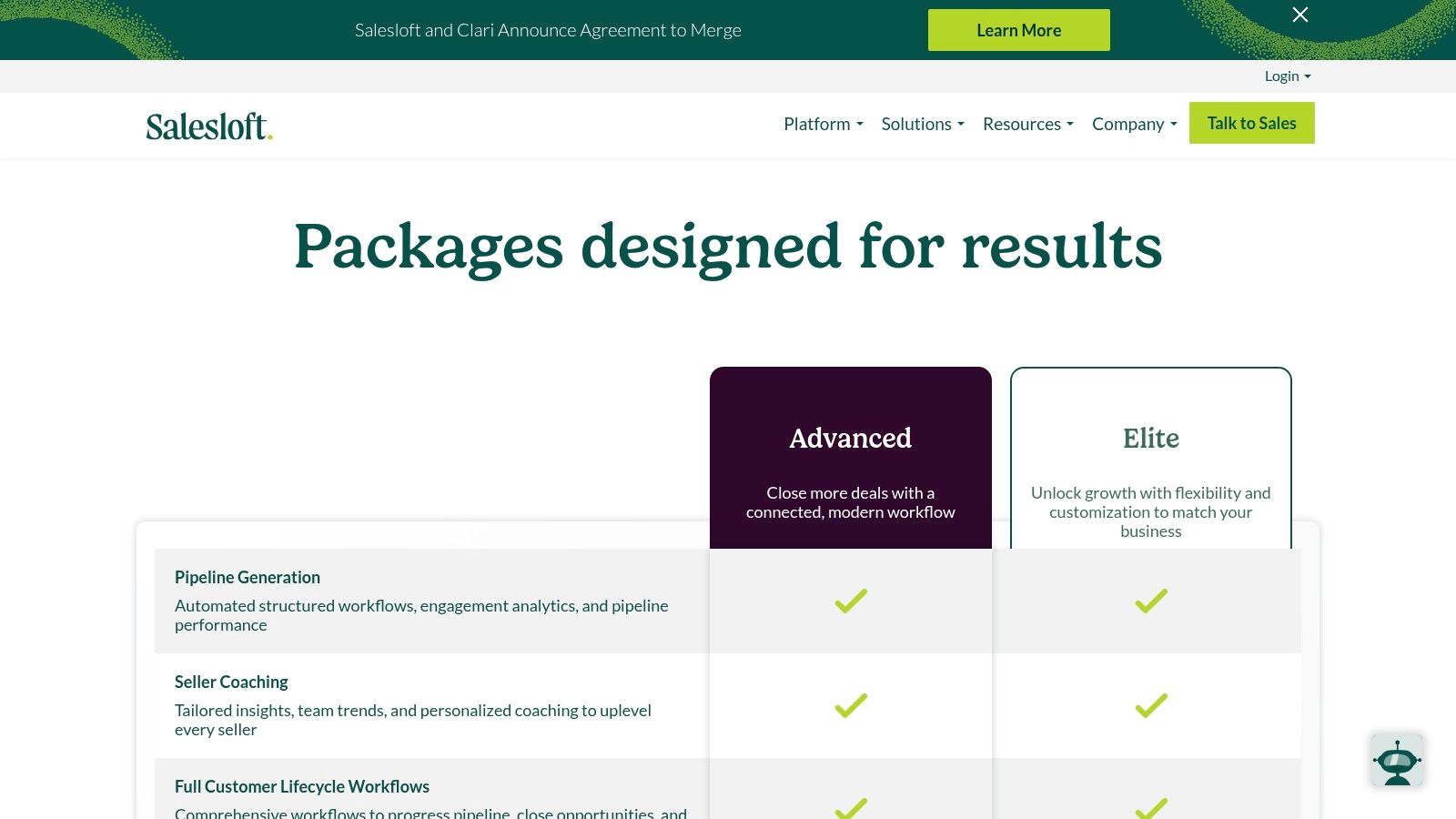
Key Features & User Experience
Salesloft's interface is clean and activity-focused, designed to guide reps through their daily tasks efficiently. The platform’s analytics are a significant differentiator, providing deep insights into team performance and engagement metrics.
- Cadences & Automation: Build, test, and execute multi-channel outreach sequences to streamline prospecting efforts.
- Integrated Dialer & Messenger: Make calls, send texts, and drop voicemails directly from the platform, with all activity logged automatically.
- Conversation Intelligence: Record, transcribe, and analyze sales calls to identify best practices and provide targeted coaching.
- Bi-Directional CRM Sync: Ensures seamless data flow between Salesloft and major CRMs like Salesforce, keeping all records accurate and up-to-date.
Practical Tip: Use the A/B testing feature within Cadences for your email steps. Test different subject lines or calls-to-action on a small segment of your prospect list to identify what resonates best before rolling it out to a larger audience.
Pros:
- Robust feature set covering the entire sales engagement lifecycle.
- Strong analytics and coaching tools to improve team performance.
- Widely adopted with a strong, active user community for support.
Cons:
- Pricing is not publicly listed and requires contacting their sales team.
- Its extensive features may overlap with other tools in your tech stack.
- Can be complex to implement fully without dedicated administrator resources.
Website: https://www.salesloft.com/pricing
8. Cognism
Cognism is a B2B sales intelligence platform that has carved out a strong reputation for providing high-quality, globally compliant contact data. Its primary differentiator is a focus on data accuracy and extensive coverage in the EMEA market, making it an essential tool for teams operating under strict GDPR regulations or targeting European prospects.
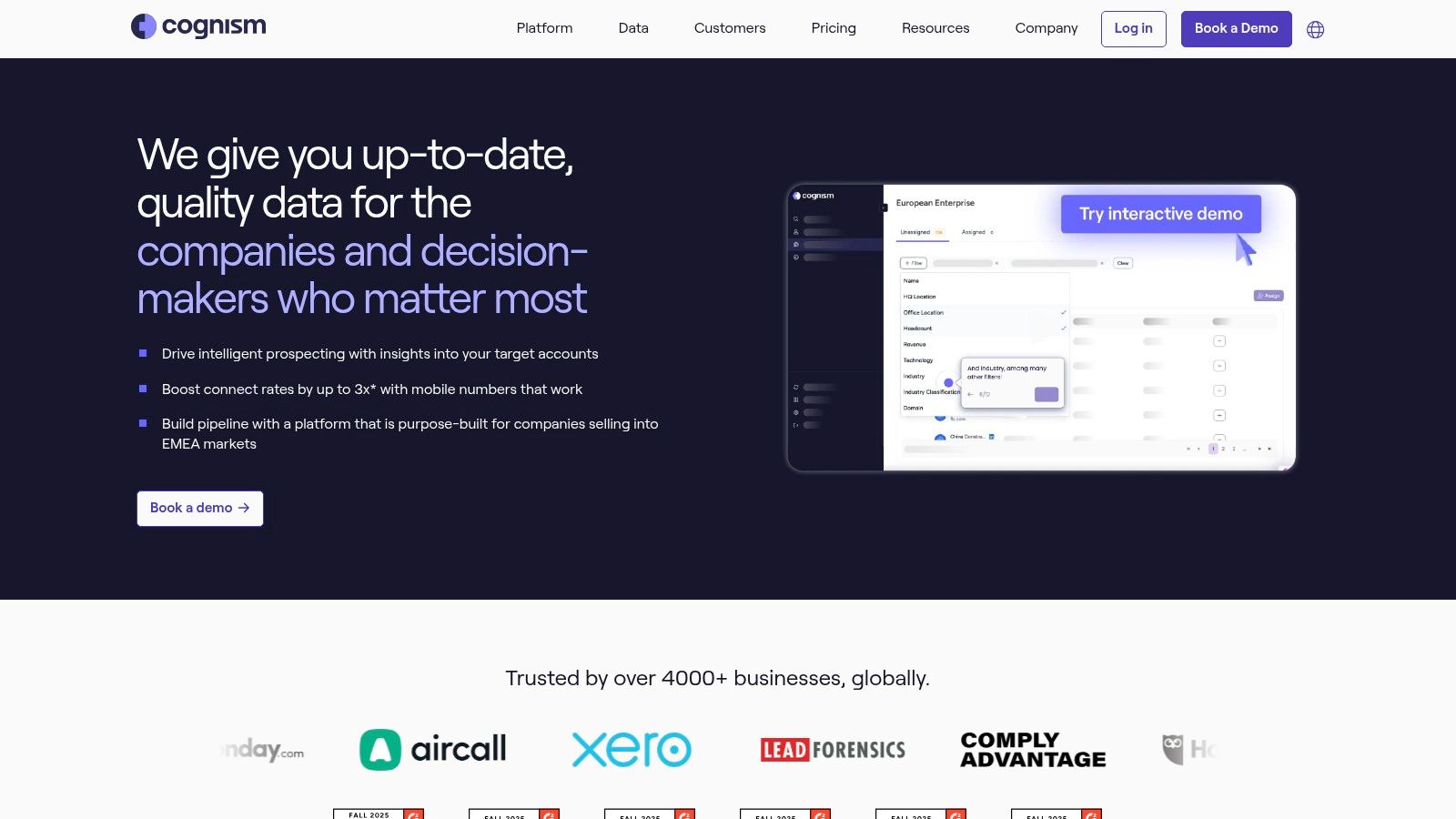
The platform’s standout offering is its phone-verified mobile numbers, branded as Diamond Data®, which undergo a manual verification process to ensure they are correct and in use. This commitment to quality helps sales teams improve connect rates and avoid wasting time on inaccurate information. Cognism also enriches its data with buyer intent signals, technographics, and firmographics, allowing for highly targeted and timely outreach.
Key Features & User Experience
The user experience is built around efficiency, with a clean interface and a robust Chrome Extension for prospecting on LinkedIn and company websites. The platform includes onboarding and training with all packages, ensuring teams can quickly get up to speed.
- Diamond Data®: Access to phone-verified mobile numbers, significantly increasing the likelihood of reaching decision-makers.
- GDPR & CCPA Compliance: A strong focus on data compliance provides peace of mind for teams prospecting in regulated regions.
- Intent Data: Integrates Bombora's intent data to identify accounts actively researching solutions like yours.
- CRM & Sales Engagement Integration: Seamlessly syncs with popular platforms like Salesforce, HubSpot, and SalesLoft to enrich existing records and streamline workflows.
Practical Tip: When building a prospect list, start by applying the "Diamond Data®" filter. This prioritizes contacts with the highest-quality, verified mobile numbers, ensuring your initial outreach has the best possible chance of success.
Pros:
- High-quality, phone-verified contact data improves connect rates.
- Excellent for GDPR-compliant campaigns and strong EMEA reach.
- Onboarding and training are included with packages.
Cons:
- Pricing is quote-based and not transparently listed.
- Some users report that US data depth can be weaker compared to its strong EU coverage.
- Access is package-based, which may be a significant investment for smaller teams.
Website: https://www.cognism.com
9. Lusha
Lusha is a B2B contact data platform known for its simplicity and accessible, credit-based model. It has become a go-to tool for sales development representatives, particularly within US-based SMBs and mid-market companies, who need fast access to direct dials and email addresses. Its strength lies in a straightforward system where credits unlock contact information, making it easy to understand and manage prospecting costs.
The platform's core value is delivered through its Chrome extension, which overlays on LinkedIn profiles and company websites, allowing reps to enrich contact data in their natural workflow. This seamless integration helps maintain prospecting momentum without constantly switching between tabs, making it one of the more efficient sales prospecting tools for high-volume outreach.
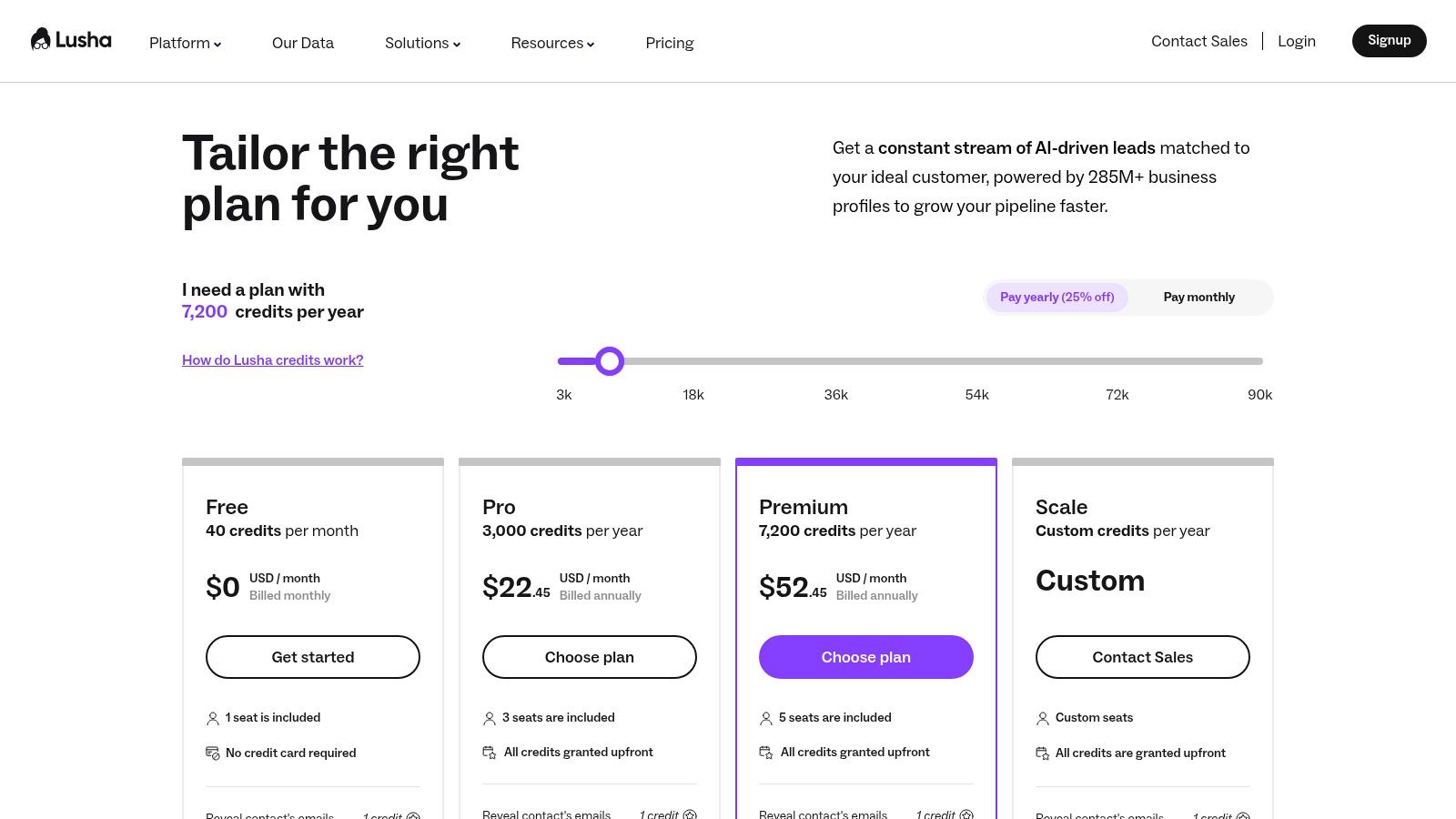
Key Features & User Experience
Lusha’s interface is clean and centered around its credit system, which is transparent and easy to track. A single credit type can be used across its web app, browser extension, and API, simplifying budget management. Team controls also allow managers to allocate and restrict credit usage for different users, ensuring cost control across the organization.
- Credit-Based System: A unified credit system applies to emails and phone numbers, with clear rollover rules on paid plans.
- Browser Extension: Find contact data directly on LinkedIn, Salesforce, and company websites.
- Team Management: Administrators can manage credit distribution and access for team members.
- CRM Integrations: Connects with popular CRMs like HubSpot, Salesforce, and Pipedrive to push enriched contact data directly.
Practical Tip: Before committing to a large annual plan, leverage the free tier or a monthly subscription to test data accuracy within your specific industry. Data quality can vary by sector, so a small-scale test ensures Lusha is a good fit for your target market.
Pros:
- Generous free plan makes it easy to get started and evaluate the tool.
- Simple, easy-to-understand credit consumption model.
- Flexible monthly and annual subscription options.
Cons:
- Advanced features like intent data and bulk CSV enrichment are gated in higher-tier plans.
- Phone number credits are more expensive than email credits.
- Careful plan selection is needed to manage costs effectively as usage scales.
Website: https://www.lusha.com/pricing/
10. Clearbit by HubSpot
Clearbit, now part of the HubSpot ecosystem, operates as a powerful B2B data enrichment and web intelligence engine. Its primary strength is its ability to reveal the companies visiting your website and enrich your CRM contacts with over 100 firmographic and technographic data points, turning anonymous traffic into actionable leads. This makes it an invaluable tool for understanding your audience and prioritizing high-fit accounts.
The platform excels at augmenting existing HubSpot data, allowing sales and marketing teams to build highly targeted segments and automate lead routing. By identifying anonymous website visitors and enriching inbound leads instantly, Clearbit ensures your sales team engages with the most qualified prospects first, armed with the context needed for a relevant conversation.
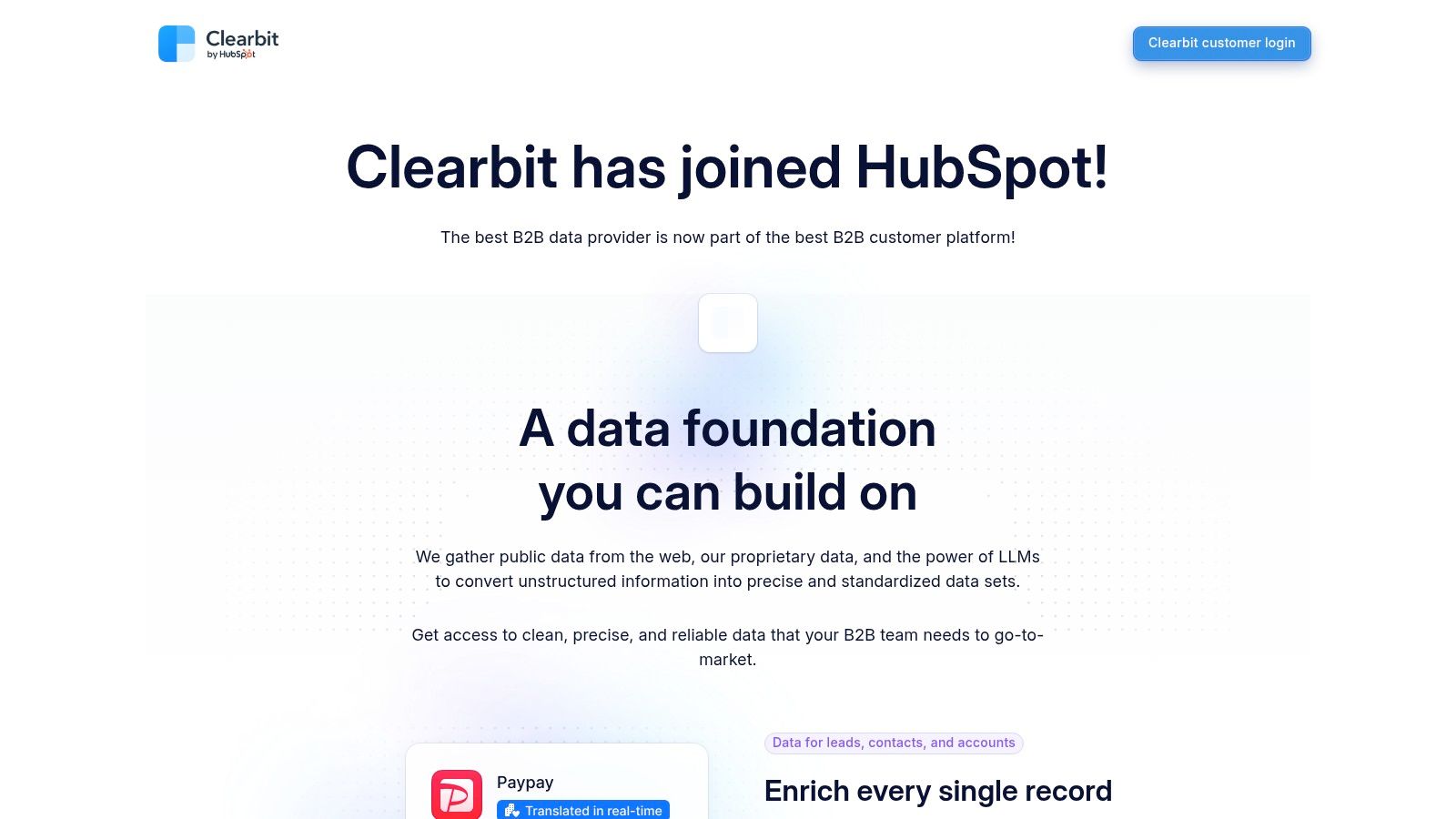
Key Features & User Experience
The user experience is designed for deep integration within HubSpot, making data accessible directly inside contact, company, and deal records. This native feel simplifies workflows, eliminating the need to switch between different applications for prospecting intelligence. A key feature is its real-time data enrichment, which automatically appends company details the moment a new lead enters the CRM.
- Company & Contact Enrichment: Automatically adds firmographic data like employee count, industry, revenue, and location to your HubSpot records.
- Web Visitor Intelligence: Identifies anonymous companies visiting your website, tracking their on-site behavior to gauge intent.
- Technographic Data: Reveals the technology stack a company uses, providing key insights for personalized outreach.
- HubSpot Workflow Integration: Use Clearbit data as triggers and filters within HubSpot’s automation and lead scoring workflows.
Practical Tip: Create a HubSpot workflow that automatically creates a task for the account owner when a target account (defined by Clearbit data like employee size and industry) visits your pricing page. This ensures immediate, high-priority follow-up.
Pros:
- Seamless native integration within the HubSpot ecosystem.
- Simplifies data operations for teams already standardized on HubSpot.
- Strong data accuracy for company-level enrichment.
Cons:
- Legacy free tools are being sunset, making it primarily a paid solution.
- Pricing and access are managed through HubSpot, often requiring custom quotes.
- Value is maximized when deeply embedded in HubSpot, offering less for non-users.
Website: https://clearbit.com
11. LeadIQ
LeadIQ is a sales prospecting tool designed to streamline the process of capturing and enriching contact data directly from LinkedIn and company websites. Its core value is speed and accuracy, allowing sales development representatives (SDRs) to quickly build prospect lists with verified emails and mobile numbers, reducing time spent on manual research.
The platform operates primarily through a Chrome extension that sits on top of LinkedIn Sales Navigator or company pages. This allows users to capture prospect information in real-time and, with a single click, push that enriched data directly into their CRM or sales engagement platform, like Salesforce, HubSpot, or Outreach.
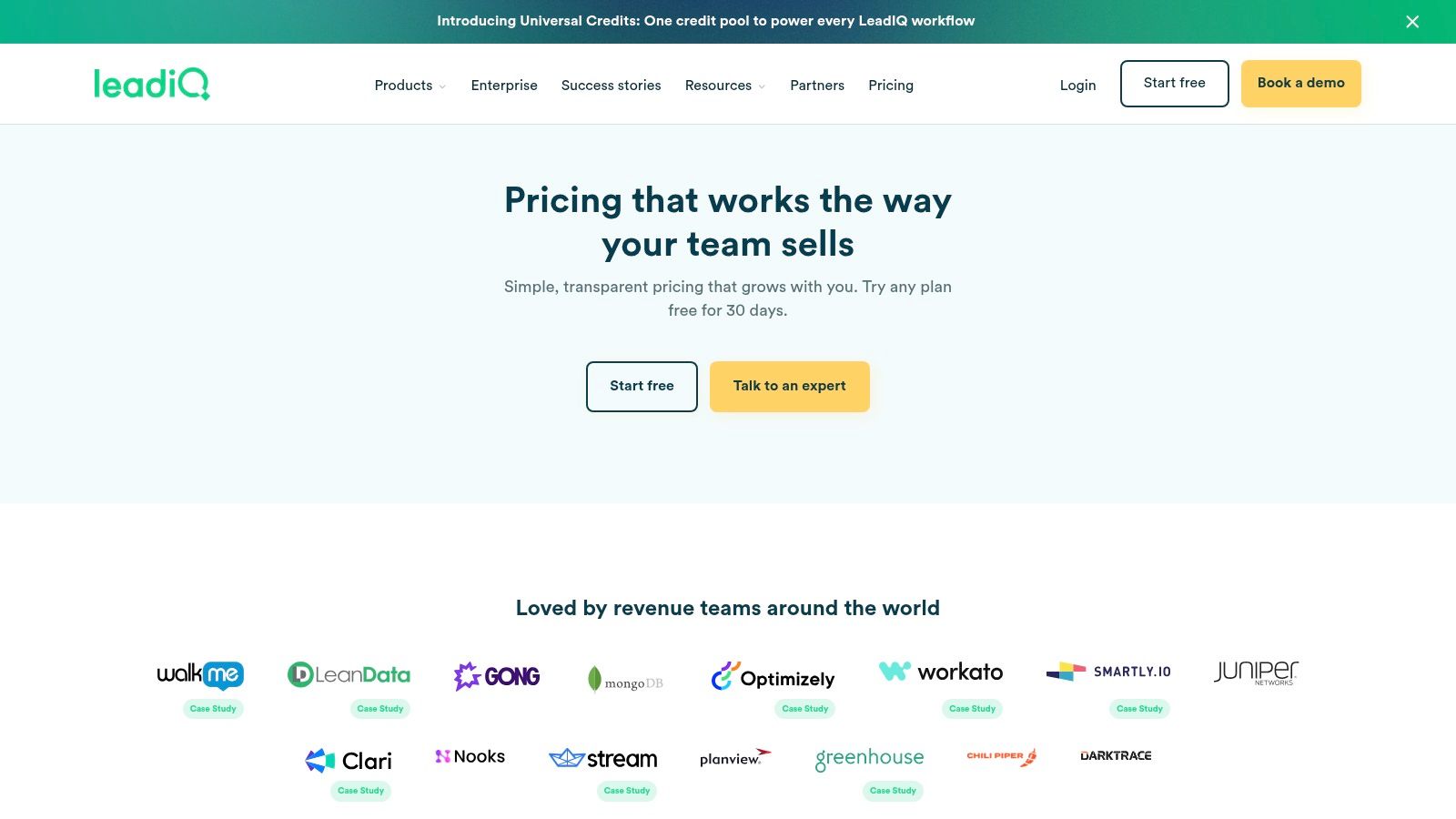
Key Features & User Experience
LeadIQ's user experience is built for efficiency, minimizing clicks and context switching between different applications. The extension is intuitive, and its one-click sync functionality is a standout feature that integrates seamlessly into an existing research-to-outreach workflow.
- Chrome Extension Capture: Easily grab verified work emails and mobile numbers from LinkedIn profiles and web pages.
- One-Click Sync: Push enriched contact and account data directly to Salesforce, HubSpot, Salesloft, and Outreach.
- Job-Change Tracking: Receive alerts when contacts in your CRM change jobs, signaling new opportunities.
- Data Enrichment: Automatically finds and verifies contact information, ensuring data quality before it enters your system.
Practical Tip: Use LeadIQ’s capture feature in batches while prospecting on LinkedIn Sales Navigator. Build a list of 10-15 relevant prospects, capture them all at once, and then sync to your sales engagement platform to immediately enroll them in a sequence.
Pros:
- Excellent for accelerating the top-of-funnel workflow.
- Transparent, credit-based pricing with self-serve options.
- Strong integrations with major CRMs and sales engagement platforms.
Cons:
- Effectiveness is heavily tied to having a LinkedIn Sales Navigator subscription.
- It is not a standalone engagement platform, requiring other tools for outreach.
- Teams must carefully manage their credit usage to control costs.
Website: https://leadiq.com/pricing
12. G2 – Sales Intelligence Category
While not a prospecting tool itself, G2’s Sales Intelligence category is an indispensable resource for evaluating and comparing the best sales prospecting tools on the market. It serves as a comprehensive marketplace, aggregating verified user reviews, detailed feature comparisons, and real-time satisfaction scores to help sales leaders make informed purchasing decisions.
The platform’s strength lies in its Grid® reports, which visually plot vendors based on market presence and user satisfaction, identifying "Leaders," "Contenders," and "Niche" players. This allows teams to quickly shortlist solutions that match their specific needs, from enterprise-grade platforms to more specialized tools, and see how they stack up against direct competitors based on authentic user feedback.
Key Features & User Experience
Navigating G2 is straightforward, with powerful filters to sort tools by company size, industry, or specific features. The platform provides direct access to vendor profiles, pricing information, and links to free trials, streamlining the entire research-to-purchase journey.
- Verified User Reviews: Access thousands of detailed reviews from real users, offering honest insights into a tool’s performance and support.
- Side-by-Side Comparisons: Directly compare up to four different tools on features, pricing models, and user ratings.
- Grid® Reports & Rankings: View dynamic, data-driven rankings that are updated quarterly to reflect the current market landscape.
- Alternatives Pages: Discover competing products and understand why users might choose one solution over another.
Practical Tip: When researching, pay close attention to the "Reviews by Role" filter. A sales manager's perspective on a tool's ROI will differ significantly from a BDR's experience with its daily usability and workflow integration.
Pros:
- Neutral, user-driven data provides an unbiased view of the market.
- Freely accessible and regularly updated with the latest reviews and data.
- Simplifies the complex process of comparing multiple vendors.
Cons:
- Pricing information can sometimes lag behind official vendor updates.
- Users must be mindful of sponsored placements that may influence visibility.
- The sheer volume of information can be overwhelming without a clear research goal.
Website: https://www.g2.com/categories/sales-intelligence
Top 12 Sales Prospecting Tools Comparison
| Platform | Core Features/Capabilities | User Experience & Quality ★ | Value & Pricing 💰 | Target Audience 👥 | Unique Selling Points ✨ |
|---|---|---|---|---|---|
| 🏆 Intently | AI-driven social listening on Reddit, X, LinkedIn; sentiment & urgency analysis | ★★★★☆ Real-time alerts via Email & Slack | From $49/mo; flexible credit system | Solopreneurs, GTM teams, sales, marketers | Custom intent signals; scalable seats; seamless GTM workflow integration |
| LinkedIn Sales Navigator | Advanced lead search; TeamLink; 50 InMails/mo | ★★★★☆ Fresh professional LinkedIn data | Subscription; clear pricing & trials | US B2B sellers, sales professionals | Native LinkedIn ecosystem; relationship map |
| ZoomInfo SalesOS | Extensive US B2B data & intent signals; CRM integrations | ★★★★★ Enterprise-grade data quality | Quote-based; typically costly | Large enterprises, US market | Detailed org charts; strong governance |
| Apollo.io | B2B data + outreach sequences + dialer | ★★★★☆ User-friendly; AI-assisted tools | Transparent per-seat pricing; free tier | SMB & mid-market US sales teams | Unified prospecting and outreach platform |
| HubSpot Sales Hub | Sales engagement + calling + AI coaching | ★★★★☆ Integrated CRM & ecosystem | Freemium to enterprise plans; variable | HubSpot CRM users, scaling teams | Native HubSpot CRM integration |
| Outreach | Multichannel sequences; AI revenue agents | ★★★★☆ Enterprise-grade sales productivity | Quote-based; premium pricing | Enterprise sales organizations | Multichannel + AI-driven sales enhancements |
| Salesloft | Sales sequencing, coaching, analytics | ★★★★☆ Strong adoption & community | Quote-based pricing | Progressive sales teams | Bi-directional CRM sync; forecasting add-ons |
| Cognism | Phone-verified EU & US data; GDPR compliant | ★★★★☆ High-quality contact data | Quote-based; onboarding included | US teams targeting EMEA/GDPR | EU GDPR focus; Diamond Data mobile coverage |
| Lusha | Credit-based B2B contacts & prospecting | ★★★☆☆ Simple credit model | Subscription; free tier with credits | SMBs & mid-market sales development reps | Easy entry; flexible monthly/annual plans |
| Clearbit by HubSpot | Data enrichment + web visitor intelligence | ★★★★☆ Seamless HubSpot ecosystem | Quote-based via HubSpot | HubSpot users | Native HubSpot enrichment & segmentation |
| LeadIQ | Prospecting capture & enrichment via Chrome ext | ★★★☆☆ Fast workflows; credit-based pricing | Transparent credit plans | Sales reps using LinkedIn | One-click enrichment; job-change alerts |
| G2 – Sales Intelligence | Rankings, reviews, feature matrices | ★★★★☆ Neutral, comprehensive marketplace | Free access | Buyers & researchers | Verified user reviews; direct trial links |
Final Thoughts
Navigating the expansive landscape of sales prospecting tools can feel overwhelming, but the right technology is no longer a luxury; it’s a foundational component of any successful sales strategy. Throughout this guide, we've explored a dozen of the best sales prospecting tools available today, from comprehensive all-in-one platforms like HubSpot Sales Hub and ZoomInfo SalesOS to specialized solutions like Lusha for contact data and Outreach for engagement. Each tool offers a unique value proposition, designed to solve specific challenges in the complex process of identifying, engaging, and converting leads.
The central takeaway is that there is no single "best" tool for every organization. The ideal choice depends entirely on your specific context. A solopreneur or a small marketing team might find the integrated capabilities and affordability of Apollo.io to be a perfect fit. In contrast, a large enterprise sales organization will likely require the robust automation, deep analytics, and sophisticated sequencing offered by platforms like Salesloft or Outreach to manage their complex workflows at scale.
How to Choose Your Sales Prospecting Stack
Making the right decision requires a strategic internal assessment before you even start a free trial. Your goal should be to build a cohesive sales tech stack where each tool complements the others, rather than creating data silos or redundant functionalities.
Consider these critical factors as you move forward:
- Team Size and Structure: Is your sales development representative (SDR) team separate from your account executives? Your chosen tool must support the distinct workflows and handoffs between these roles. Platforms like LinkedIn Sales Navigator are invaluable for individual prospectors, while more integrated systems are needed for collaborative teams.
- Integration is Non-Negotiable: Your prospecting tool must seamlessly connect with your existing CRM. A lack of native integration can lead to manual data entry, lost information, and a fragmented view of the customer journey. Always verify compatibility with your core systems, whether it's Salesforce, HubSpot, or another platform.
- Data Quality and Compliance: In an era of increasing data privacy regulations like GDPR and CCPA, the source and accuracy of your prospecting data are paramount. Ask vendors like Cognism or ZoomInfo about their data verification processes and commitment to compliance to protect your business from potential legal and reputational risks.
- Focus on Intent vs. Static Data: Traditional prospecting often relies on static firmographic and demographic data. However, the most powerful modern strategies prioritize buyer intent. Understanding when a prospect is actively researching solutions like yours is the ultimate competitive advantage. This is where tools that specialize in identifying active buying signals truly shine, transforming your outreach from a cold interruption into a timely, relevant conversation.
Implementing Your Tools for Maximum Impact
Once you’ve made your selection, successful implementation is key to unlocking its full potential. Don't just hand the software over to your team and expect immediate results.
- Invest in Training: Dedicate time for comprehensive onboarding and continuous training.
- Define Your Ideal Customer Profile (ICP): Use your new tool’s filtering capabilities to build precise lists based on a clearly defined ICP.
- Establish Clear Workflows: Document how the tool fits into your daily sales process, from initial research to logging activities in the CRM.
- Measure and Iterate: Track key metrics like connection rates, meetings booked, and conversion rates to measure ROI and identify areas for improvement.
Ultimately, the best sales prospecting tools are those that empower your team to work smarter, not just harder. They automate tedious tasks, provide actionable insights, and clear the path for sales representatives to do what they do best: build relationships and close deals. By carefully evaluating your needs and strategically implementing the right technology, you can build a predictable and scalable pipeline that fuels sustainable growth.
Ready to move beyond static lists and start engaging prospects who are actively looking for your solution? Intently specializes in identifying high-value buyer intent signals, delivering qualified leads directly to your team when their interest is at its peak. Discover how our unique approach to intent data can transform your prospecting efforts by visiting Intently to learn more.
